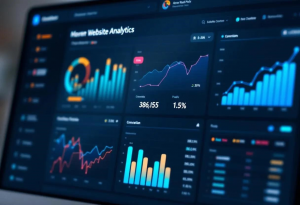Unlocking Growth: Measuring the ROI of Your Content Marketing

Content. It’s everywhere, right? Blog posts, videos, infographics… the whole shebang. We’re told it’s the thing. But here’s the million-dollar question: Is all that effort actually paying off? Are you seeing a real return on your investment (ROI)? That’s what we’re diving into.
I’m Mark Olsen. For years, I’ve helped businesses – from tiny startups to huge corporations – figure out if their content is working. And more importantly, how to make it work. Because let’s face it, creating content is only half the battle.
Why Bother Measuring ROI?
Simple. If you’re not measuring, you’re guessing. And guessing with your marketing budget? Not a great plan. Content marketing isn’t just about making noise. It’s about getting real results. Measuring ROI lets you:
- Keep the budget flowing: Show the people in charge that your content is actually making money.
- Make smarter choices: Ditch what’s not working and double down on what is.
- Get better results, faster: Tweak your approach based on what the data tells you.
- Spend wisely: Put your resources where they’ll have the biggest impact.

What Numbers Should You Watch?
Okay, so what should you be tracking? Don’t worry, it’s not as complicated as it sounds. Here are some key metrics to keep an eye on:
- Website Traffic: Are more people visiting your site? Use Google Analytics. It’s free and tells you where your visitors are coming from and which content brings them in.
- Engagement: Are people actually reading/watching/listening? Look at things like time on page, how many people bounce away quickly, comments, shares, and social media love.
- Leads: Are you grabbing contact info? Track form submissions, email sign-ups, and downloads (like that free ebook you offered).
- Conversion Rates: Are leads turning into paying customers? See how content influences people to buy.
- Customer Acquisition Cost (CAC): How much does it cost to get a new customer with content? Compare that to other marketing methods.
- Customer Lifetime Value (CLTV): How much money does a customer bring in over their entire relationship with you? Good content can make that number go up.
- Search Engine Rankings: Are you showing up higher on Google? Track your target keywords.
- Backlinks: Are other websites linking to your stuff? That’s a good sign Google likes you.
Tools of the Trade
You don’t have to do all this in a spreadsheet (unless you really want to). Plenty of tools can help. Think of them as your content marketing sidekicks.
- Google Analytics: Your free website traffic headquarters.
- Google Search Console: See how your site is doing in Google’s eyes.
- Social Media Analytics: Facebook, Twitter, LinkedIn all have their own built-in trackers.
- Marketing Automation Platforms: HubSpot, Marketo, Pardot – these can track leads, conversions, and customer behavior. They’re a bigger investment, but powerful.
- SEO Tools: SEMrush, Ahrefs, Moz – for digging deep into keywords, backlinks, and website authority.
- Content Management Systems (CMS): WordPress (and others) often have plugins to track how your content is performing.
ROI: The Simple Math
Okay, let’s get to the actual calculation. It doesn’t need to be scary. Here’s a simple way to think about it:
- What did you spend? Add up everything: salaries, tools, freelancers, the works.
- What did you make? How much revenue did your content directly generate? Sales? Leads? Something else you can measure?
- The Formula: ROI = (Return – Investment) / Investment * 100
Example time! You spent $10,000 on content, and it brought in $30,000 in revenue.
ROI = ($30,000 – $10,000) / $10,000 * 100 = 200%
That means for every dollar you put in, you got two back. Not bad, right?
Common Roadblocks (and How to Jump Over Them)
Measuring ROI isn’t always sunshine and rainbows. Here are some challenges you might face:
- Figuring Out Where the Sale Came From: Did they see your blog post, then get an email, then finally buy? This is called attribution. Multi-touch attribution models can help.
- The Long Game: Content marketing often takes time. Don’t expect overnight miracles. Track early signs like website traffic and engagement.
- Data Overload: Data lives in different places. Connect your tools and create a central dashboard.
- What Does “Success” Even Mean?: Define your goals before you start creating content. What are you trying to achieve? More leads? More sales? Brand awareness?
Real-World Win: From Abandoned Carts to Happy Customers
I once worked with an e-commerce company that had a problem: people were adding stuff to their cart, but then leaving before buying. We dug into the data and found out why: people had questions about the products and weren’t finding the answers. So, we created blog posts and email campaigns that addressed those concerns.
The result? Conversion rates went up, and cart abandonment went down. We could directly link the content to the increased revenue. Boom. ROI proven.
Okay, What Should I Do Right Now?
Ready to get serious about content marketing ROI? Here’s your action plan:
- Set crystal-clear goals: What do you really want to achieve?
- Pick your key metrics: Focus on the numbers that matter most to your goals.
- Get the right tools: Implement tracking and analytics.
- Dive into the data: Look for patterns and areas to improve.
- Tweak, tweak, tweak: Adjust your strategy based on what you learn.
- Experiment! Try new things and see what resonates with your audience.
The Takeaway
Measuring content marketing ROI is non-negotiable. It’s how you prove its value, optimize your efforts, and drive real business growth. So, start tracking, start analyzing, and start seeing the real power of content.
Want to see what content marketing can really do for your business? Let’s chat.



